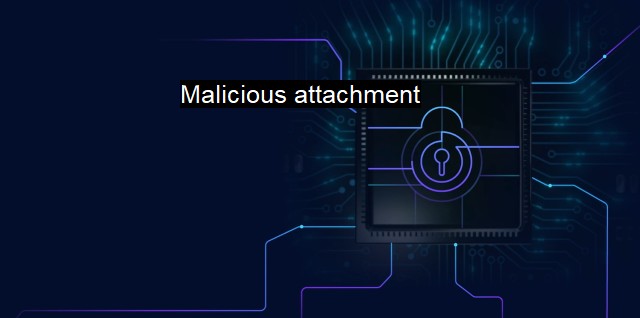What is Malicious attachment?
Protecting Your Systems: Understanding and Preventing Malicious Attachments in the Cybersecurity Landscape
Malicious attachment, an increasingly threatening term where cyber security is concerned, is a dangerous strategy employed by cybercriminals to infiltrate systems and networks, spreading infections and causing havoc. In its bare essence, a malicious attachment is a file or link, unsolicited and harmful, embedded within an unsuspicious email or message that appears to be from a reputable entity, person, or service.The phenomenon of malicious attachments is prevalent as cyber attackers exploit individual or organizational tendencies to regard all emails as harmless. Unsuspecting users clicks on or download these "attachments", deploying the hidden threats. These threats are numerous, ranging from viruses, of which there are many strains, to malicious software - collectively known as malware.
Malware, the common umbrella under which various cyber threats exist, encompasses Trojan horses, worms, adware, spyware, ransomware, rootkits, and other malicious programs designed to harm computer systems, networks, or individual users. Evolving quickly with increasing degrees of sophistication and innovative bypasses around security measures, malware is testament to the intelligence, perseverance, and destructiveness of cyber attackers.
When it comes to the transmission of malware, the methodology of attaching these threats to unsuspecting emails or messages serves as a deceptively effective approach. Disguised as something as harmless and everyday as a PDF, Word document, an image, even a legitimate software download, a malicious attachment goes generally unnoticed till the payload is released - payload being the code that initiates the malicious activity.
A variety of things can happen upon clicking on a malicious attachment. From keyboard logging which tracks your every keystroke, capturing passwords and potentially confidential information, to ransomware attacks where the hacker encrypts your files and demands ransom for their release. Sometimes the damage may not be immediately apparent. Often, these attachments are used as a sort of trojan horse, allowing more significant attacks to happen down the line. Information could be stealthily siphoned for days or months before the discovery of a security breach.
It's no longer a question of if you might encounter a malicious attachment but when. Cyber attackers have expanded their arsenal manifold and have become more innovative in driving their attacks. Their strategic campaign of deceit often calls upon a variety of disguises contemplating rotating, puzzling premises ranging from tax charge errors, charitable donations, job offers, discounted freebies, and many more.
The key to resisting these scams is an aggressive and proactive stance on cybersecurity hygiene-both individual and organizational. This comprises extensive email vetting, categorically avoiding opening, responding to, or interacting with elements of suspicious messages, rigorous and regular system updates that stay in line with newly recognized threats, top-notch antivirus software usage, firewalls, data backups, and stringent privacy settings. Taking the time to double-check the integrity of an attachment or link before clicking it can make a big difference in dodging a malicious attachment. An old principle holds true: Prevention is better than cure.
Human error or negligence often remains the chink in the armor that malicious attachments exploit. Education and awareness are integral to best practices in cybersecurity hygiene. Investing in employee training programs highlighting the detection of phishing attempts, distinguishing between malicious and authentic software or email, and safe browsing habits can effectively mitigate risks.
It is evident that 'malicious attachment' is a significant concern in the cyberspace landscape it is well within human control to empower individuals and organizations with the required skill and awareness to resist and discard such practices holistically. An informed and vigilant person empowered with robust cybersecurity mechanisms would be a challenging target for any cyber attacker to conquer.

Malicious attachment FAQs
What is a malicious attachment?
A malicious attachment is a file, document, or link that is intentionally crafted to deliver malware, viruses, or other harmful software to a device or network.How can I identify a malicious attachment?
One way to identify a malicious attachment is to look out for suspicious file extensions, such as .exe or .bat. Other red flags may include unexpected or unsolicited emails, generic sender addresses, or strange subject lines.How can I protect my computer from malicious attachments?
You can protect your computer from malicious attachments by using antivirus software, keeping it up-to-date, and avoiding opening suspicious email attachments or clicking on unfamiliar links. It is also important to regularly back up your data and to avoid installing software from unknown or untrusted sources.What should I do if I receive a suspicious email with a potential malicious attachment?
If you receive a suspicious email with a potential malicious attachment, do not open it or click on any links. Instead, delete the email immediately and run a full virus scan with your antivirus software. If you are unsure whether an email is legitimate or not, contact the sender separately to confirm its authenticity.| | A | | | B | | | C | | | D | | | E | | | F | | | G | | | H | | | I | | | J | | | K | | | L | | | M | |
| | N | | | O | | | P | | | Q | | | R | | | S | | | T | | | U | | | V | | | W | | | X | | | Y | | | Z | |
| | 1 | | | 2 | | | 3 | | | 4 | | | 7 | | | 8 | | |||||||